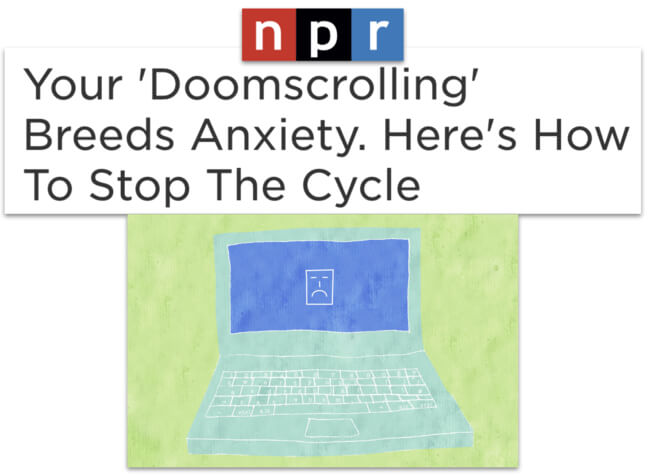末日滚动:11位专家分享如何停止消极情绪的技巧
Green Zone App
(Click here to learn more)
Dangerous Social media challenge
(Click here to learn more)
Red Zone App
(Click here to learn more)
Gray Zone App
(Click here to learn more)

我们知道,在 “末日卷轴” 或 “末日冲浪” 方面,我们成年人和青少年一样糟糕。没听说过?这是消费无休止的负面在线新闻的行为。很多人无能为力。我们喜欢读悲伤的消息、令人沮丧的消息,以及简直令人沮丧的新闻。那么,我们如何为自己结束末日卷轴的循环,并教导我们的青少年如何阻止这种循环呢?
我们邀请了11位专家分享他们的技巧和想法,告诉他们如何教导青少年停止末日卷土重来,寻找积极的一面,并教他们认识到新闻和社交媒体可能对他们的心理健康产生的负面影响。
1。随着青少年的不断发展,不要害怕干预

萨巴·哈鲁尼·卢里,创始人, 服用根部疗法
在与我们的孩子合作帮助他们管理与新闻、社交媒体和末日卷轴的关系时,我们可以记住几件事。 首先,如果我们努力停止末日滚动或限制社交媒体的使用,那么指望我们的青少年轻易停止使用是不现实的。 当我们意识到他们的前额叶皮层仍在发育中,这使得他们更难管理冲动控制时,情况就更是如此。
社交媒体努力使我们保持连接状态,保持滚动浏览,并在我们这样做的同时继续关注付费广告。因此,与其指望我们的十几岁的孩子能够独自面对这个问题,不如干预我们的父母会有所帮助。这可能看起来像是设置计时器,有时无法访问手机(或者在某些时候关闭 WiFi,或者使用关闭手机的应用程序),例如 休息时间)。
与您的青少年讨论他们在使用社交媒体时的感受,他们可能会注意到哪些触发因素使他们想要登录社交媒体,以及社交媒体是如何运作的,也可能会有所帮助。 这些类型的真实讨论可以帮助他们在消费方面更加挑剔,并在他们过渡到成年后继续养成围绕科技和媒体的健康习惯。
2。解释修养理论,鼓励正面故事的平衡

米歇尔·拉姆齐, 宾州州立大学伯克斯分校
修炼理论表明,末日卷轴的主要危险在于,我们对世界负面故事的接触越多,我们对世界的看法就越消极。 研究员乔治·格布纳称这种特殊类型的培养为 “卑鄙世界综合症”,它不仅可以为我们如何看待世界着色,还可以为我们选择如何与世界和世界中的人互动增添色彩。
为了保护青少年免受末日卷轴影响他们对世界的看法,我们可以做的一件事就是向他们解释修养理论,特别是指出经常接触悲伤或令人沮丧的故事对他们对世界的看法的破坏性影响。
此外,我们可以鼓励他们在这些故事与其他更积极的故事之间取得平衡。 教授这种重要的媒体素养理论是帮助确保青少年不会培养对世界的不正确和过于消极的看法的关键。
3.与其关注末日滚动,不如订阅积极、感觉良好的博客和网站
詹姆斯皮尔森,首席执行官兼小型企业传播者, Eventuring 企业
我曾经是一名末日滚动者。但是,成为一个人并不意味着你无法克服这种可能影响心理健康的有毒习惯。以下是与社交媒体保持良好关系并避免末日卷土重来的一种有效方法:
订阅时事通讯、网站和社交媒体账户,营造愉快的氛围。
保持边界免受灾难性新闻的影响可能很艰难。但是,如果你能集中精力,关注能让数字空间变得更美好的网站,那就容易多了。按下订阅按钮,关注那些宣传积极性、感激之情、康复、善良甚至开怀大笑的网站。这些令人振奋的内容将通过在Feed中填充感觉良好的素材来帮助你征服末日卷轴。 它需要时间、精力和意愿来激发你的思想并保持良好的心理健康。 因此,你有责任选择和管理你脑海中浮现的东西。你需要对自己参与的网站或内容有意和挑剔的态度。有了这个,它将帮助你避免末日滚动可能带来的危险。
4。教导你的孩子自己识别末日滚动,创造自己的力量来关闭应用程序
约翰·罗斯,总裁兼首席执行官, 备考洞察

为了帮助青少年避免末日卷土重来,我们能做的最好的事情之一就是以身作则。如果青少年经历的所有日常活动和生活事件都是负面的,这将激发他们对更多负面新闻的胃口。 我们需要做的是向他们展示积极的经历和有趣的活动,让他们对生活充满热情。 这样,当他们进入末日卷轴时,他们就会有说话的心态和能力,”这太负面了,我需要停止滚动”,然后关闭应用程序。你想让他们自己做。当负面情绪过多时,简单地告诉他们关闭浏览器或应用程序是行不通的!
青少年不想听。 相反,我们需要专注于树立积极的态度,这样他们就不想被打倒。 带你的孩子去听音乐会、棒球比赛,一起看有趣的电影,随机去一个有趣的地方旅行,或者干脆做一些小事,比如出人意料地跑去吃冰淇淋。只要你在做一些有趣和积极的事情,一起做什么都没关系。这将有助于培养积极的态度,因此他们将希望结束末日卷轴,而不是被告知要这样做。
5。以身作则

克莱尔·斯台普顿, Stapo 的 Thrifty Life Hacks
我们需要教导学校自我保健和戒烟的重要性。教育很重要,孩子们需要知道,消费过多的负面新闻会影响他们的心理健康。 实践自己所宣讲的话也很重要,如果你经常自己做,就不能告诉青少年不要走末日卷轴。 我自认是末日滚动者。我知道这对我没有好处,但我仍在读我能找到的最惨淡、最令人沮丧的新闻。为了克服这个问题,我设定了一些基本规则。
我的手机有晚上 8 点的宵禁,我会在另一个房间里过夜插上电源。我发现这可以帮助我晚上关机睡觉。对我们所有人来说,这样做必须变得司空见惯,因为从文化上讲,我们都需要做出改变,这样年轻一代才能知道末日卷轴是不健康的。并非总是可以做出这样的调整,但是尝试减少消耗很重要。
公开谈论你通过做出改变所获得的任何好处也是件好事。解释你的睡眠好多了,与你感受的时刻的联系有多紧密,以及你现在如何因为不经常陷入末日卷轴而有更多时间去追求自己的爱好,这将影响我们周围的青少年。 通过表达好处,青少年将看到放下手机/笔记本电脑/平板电脑可能是积极的。
6。快速尝试社交媒体
尼尔·罗奇, Boxroom 办公室
打破末日卷轴成瘾的一种方法是向青少年解释,大多数应用程序在设计时都考虑到了游戏化。青少年不喜欢被控制的想法,因此他们可能不喜欢大多数应用程序的设计正是为了做到这一点。
比这更有效的是 脱离社交媒体 还有末日卷轴。在社交媒体上快速挑战 72 小时的青少年。也许可以找一个值得信赖的第三方来更改他们的密码,这样他们就不会因为重影到自己喜欢的应用程序而意外地复发。
在三天结束时,询问他们是否因无法上网而感到任何戒断症状。然后解释一下,他们所感受到的焦虑和不安是因为他们在心理上沉迷于那些对他们没有真正好处的无用信息的数据源。
7。不要用《末日卷轴》破坏你的心理健康

海因里希·朗,隐私专家, 恢复隐私
末日滚动是一种自我破坏的形式。 它让互联网偷走了你的快乐。远离互联网和社交媒体很困难,但我发现行之有效的方法是找到一个 离线活动 以取代你花在手机上的时间。制定一个可靠的计划,不要让任何空闲时间填满,因为那时你会出于习惯而被诱惑到末日滚动。把手机放在遥不可及的地方,去看电影、和狗一起玩、画画或读书。他们最喜欢的节目或与朋友的聊天可能会让青少年感到安慰。他们真的需要它。
8。收听播客或在非营利组织做志愿者
约瑟夫·萨利姆, 萨顿广场牙科协会
末日滚动比以往任何时候都更加普遍。负面新闻和恐惧远不止正面事件。结果,我们不断受到他们的轰炸,改变了我们的思维和运作方式。我们的孩子也会受到影响,如果我们对此无所作为,他们更具可塑性的思想就会受到影响。
我们需要有意识地努力淡化末日卷轴,并关注积极情绪的来源,例如 这里有 iHeartRadio 的精彩内容。这个播客通过有用的提示和分享的经验激励我们做好事。
我们需要克服恐惧,过上好像每一天都是我们的最后一天一样生活。 我们需要记住,最有价值的是我们留下的遗产。 没有什么比每天努力成为一个更好的人,同时触动他人的生活更有意义的了,而为非营利组织做志愿服务是实现这一目标的好方法。
9。教你的孩子自己管理和控制他们的末日卷土重来
周克洛维斯,《时代组织研究》
我认为我们可以教导青少年结束周期的一种方法是让父母定期与青少年分享快乐或令人兴奋的消息。这可以促进积极性,向青少年表明并非所有新闻都是负面的,有时我们只会看到或提供负面新闻头条。
另一种方法是让父母与孩子沟通,让他们知道如果他们感到沮丧,他们有能力控制该怎么做。 如果他们在阅读新闻后感到难过,请立即关闭该文章。 毕竟,无法全天候监控青少年,以防止他们阅读不幸的消息。他们必须学会如何管理和控制它,才能阻止这种恶性循环。
10。关闭推送通知

昆山 S 艾哈迈德,联合创始人, InsidetechWorld.com
推送通知是我们所有人沉迷于手机的主要原因之一。 它们使我们想一遍又一遍地检查不同的应用程序。你打开应用程序来查看那条通知,最后要花几个小时不仅浏览那个平台,还要花几个小时浏览其他媒体。
这是一种心理现象,一旦你进入了一个地方,即使你不想离开,即使你愿意,你也不想离开——反之亦然。因此,我们无需不惜任何代价进入应用程序,这是第一步。
教导青少年结束这个周期的一种方法是让他们关闭特定应用程序的推送通知,以免分散注意力,或者使用iPhone的 屏幕时间 该功能可在设定的时间内阻止更新和通知。 这将有助于结束这个周期,因为你的孩子只会主动检查他们的手机和各种应用程序,而不是被动地检查他们。
11。 停止在床上浏览社交媒体
雷克斯·弗莱伯格,首席执行官, 小工具评论
陷入末日卷轴的空隙非常容易,尤其是当我们的社交媒体圈子里往往是一个充满志同道合的人的回声室时。如果每个人都在挣扎,那么更容易陷入这个循环。这可能导致你永远看不到任何东西的好处。与其保持谨慎甚至有点愤世嫉俗,不如一直如此,很容易变得沮丧、幻想破灭和其他痛苦。
打破这个习惯很难。首先,一定不要在床上滚动社交媒体。这是大多数人进行末日滚动的大部分时间的地方。我还建议自己设定时间限制。
新闻中的末日滚动

“作为人类,我们有一种'自然'倾向于更多地关注负面新闻,” [一位哈佛研究人员解释说。]这加上社交媒体算法,使得末日滚动及其影响几乎是不可避免的。 有线

我们中的许多人都是这样做的:你上床睡觉,关掉灯,然后看手机再看一次Twitter... 你会看到冠状病毒感染率上升了。也许你的孩子无法回学校。经济正在崩溃... 尽管如此,当你陷入绝望之水时,你仍会持续数小时地滚动浏览无底的厄运与忧郁的新闻。 美国国家公共电台
结论
一切都始于树立我们希望青少年效仿的榜样。我们都经历了比我们想承认的要长,但是意识到陷阱并退出负面新闻是朝着正确方向迈出的第一步。
上面的提示对你或你的孩子有用?在评论中与我们分享。
Protect your family and enter for a chance to win cool prizes
成为会员或登录以了解有关此主题的更多信息
Protect your family and enter for a chance to win cool prizes

。,开始从这个页面学习,赚取星巴克礼品卡的积分!**
你好,我是 SmartSocial.com 的创始人乔什。
在你填写我们的反馈表之前,不要离开这个页面,该反馈表将在你从资源中学习后出现...

加入我们的 聪明 社交播客
每周在 iTunes 上
Josh Ochs 共有 240 多集,采访了心理学家、治疗师、辅导员、教师和家长,同时向你展示了如何利用社交媒体,有朝一日能在网上大放异彩。
听着:



.jpg)
.jpg)

.jpg)



